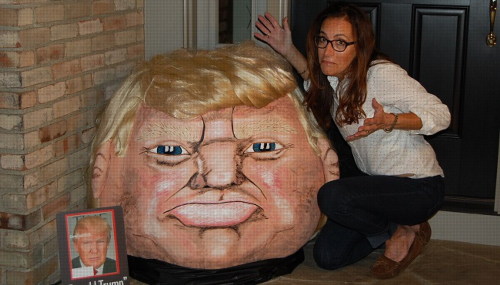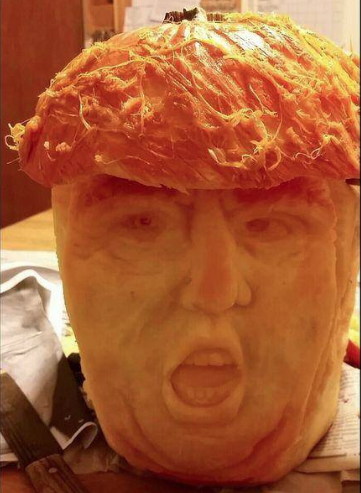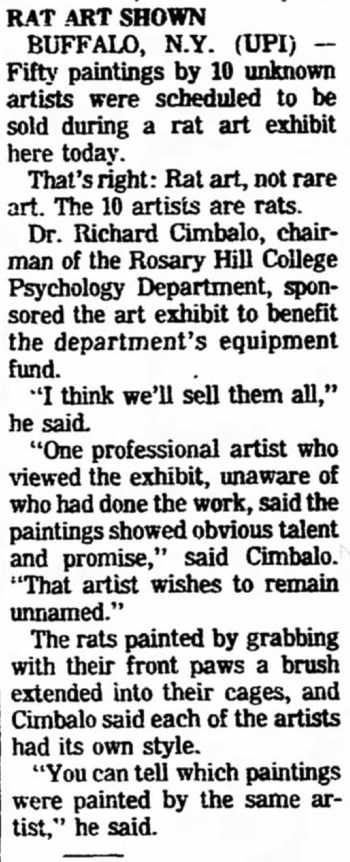Art
Art of Erasure

In her "Dictionaries" series she uses an eraser to "rub away aggressively" at words and printed definitions. (For instance, she has erased the words "white," "yellow," and "black" from old Webster's dictionaries to create "colorblind dictionaries.")
And her erasure sculptures "are made from the eraser residue, which she gathers into modest piles."
Info source: Blouin Art Info. Also check out Collins' website. Her older work appears to be more traditional charcoal and pastel sketches.
Posted By: Alex - Sun Dec 20, 2015 -
Comments (5)
Category: Art
Gang Member Rugs
Created by artist Renato Garza Cervera out of leather, polyester, polyurethane foam, glass eyes, and paint. Cervera explains that rugs used to represent fierce creatures such as lions, tigers, or bears. So he decided to create rugs that show fierce creatures with more contemporary relevance.He goes on to say that his rugs represent "Calibanization" (as in, the character Caliban from Shakespeare's The Tempest). "It's an aesthetic consideration of collective political, social and psychological mechanisms and patterns." More info: MySanAntonio.com.


Posted By: Alex - Sat Nov 28, 2015 -
Comments (7)
Category: Art, Furniture
Trumpkins
Donald Trump has become the theme of Halloween this year. People everywhere are creating pumpkins, aka Trumpkins, in his likeness. Some examples:
A 374-pound Trumpkin created by Jeanette Paras of Dublin, Ohio. wbtw.com

by Nancy Faber, via Twitter

by billybush, via Instagram
Posted By: Alex - Wed Oct 28, 2015 -
Comments (5)
Category: Art, Holidays, Politics
Canned Parrot
A soon-to-be-opened San Francisco store called Terrific Street is displaying cans of "canned parrot" in its front window. Two kinds of canned parrot are on display — "free range cherry conures in their own syrup" and "colorful sky rat boiled parrot."The store isn't actually selling canned parrot. The owner of the store has explained that the display is an "art installment" inspired by Andy Warhol's paintings of canned food, while also referring to the local wild parrot population.
Says the owner: "The thinking behind the display was to make something unusual and fun for folks to walk by between now and the time we are open for business."
More info: SFGate.com



Posted By: Alex - Wed Oct 21, 2015 -
Comments (8)
Category: Animals, Art, Food
Rat Art
March 1975: Dr. Richard Cimbalo of Rosary Hill College (now Daemen College) held an exhibition of "rat art" in order to raise money for the school's psychology department. "The rats painted by grabbing with their front paws a brush extended into their cages, and Cimbalo said each of the artists had its own style."I wonder what became of this rat art. Probably stored away in a box in someone's attic. Or tossed out.
Someone should open a Museum of Animal Art — to collect together in one place all the paintings by rats, chimpanzees, elephants, etc. that have been produced over the years.

The Desert Sun (Palm Springs, CA) - May 12, 1975

The Daily Courier (Connellsville, PA) - Mar 15, 1975
Posted By: Alex - Tue Oct 20, 2015 -
Comments (3)
Category: Animals, Art, 1970s
Postmortem Tattoo Preservation
The National Association for the Preservation of Skin Art recently launched. Its mission is to preserve the tattoos of any of its members who have died. They claim they have a "new proprietary process" of preservation which helps them to do this.Of course, to preserve the tattoo, it first has to be removed. The Association doesn't send someone out to do this. Instead, they ship a kit to the funeral home and have them do it. The end result is a nicely framed piece of tattooed human skin.
We've discussed postmortem tattoo preservation before here on WU. For instance, we've noted that as far back as 1950 the Imperial University of Tokyo was collecting tattooed skins. And more recently, tattoo enthusiast Geoff Ostling bequeathed his skin to the National Gallery in Canberra.

Posted By: Alex - Wed Oct 07, 2015 -
Comments (10)
Category: Art, Death, Skin and Skin Conditions
Trompe l’oeil in the Villa Barbaro
Wikipedia entry here.
Posted By: Paul - Fri Sep 25, 2015 -
Comments (2)
Category: Architecture, Art, Europe, Sixteenth Century
Fine Art on Billboards
1963: In response to polls indicating that a majority of the public disliked billboards along highways and were in favor of banning them, the O'Mealia Outdoor Advertising Corp. began displaying fine art masterpieces on a handful of its billboards throughout New Jersey. The idea was to show that billboards could be educational and instructive, and that they should be thought of as "the public's art gallery." Among the masterpieces displayed were Da Vinci's Mona Lisa and Gainsborough's Blue Boy.Cute idea, but it must have been difficult for motorists to fully appreciate a masterpiece as they sped by it at 60 mph. Perhaps those stuck in traffic jams could admire the art.

link: Popular Science - Oct 1965
Posted By: Alex - Thu Sep 24, 2015 -
Comments (4)
Category: Art, Museums, 1960s
Unfit Bits
Tega Brain and Surya Mattu have come up with an "art project" (Unfit Bits) that gives people practical tips on how to cheat fitness trackers, such as the Fitbit. Why would you want to cheat a fitness tracker? Perhaps because your employer is offering a financial incentive to wear the tracker and is then monitoring your data and sharing that data with an insurance company. So screw them. Take their money and supply them with a stream of bogus data.The cheat methods are as easy as tying the tracker to a pendulum or to the branch of a tree, to make it think you're walking around when you're really slouching in front of the TV. Notes Mattu, "We’re putting this kind of trust into devices that are very simple. Unfit Bits shows how silly the data is from these kinds of sensors." More info at Observer.com.
Unfit Bits from Surya Mattu on Vimeo.
Posted By: Alex - Wed Sep 23, 2015 -
Comments (9)
Category: Art, Exercise and Fitness, Technology
Putin painted by boob
The latest in boob art. Russian artist Irina Romanovskaya says she's been painting portraits of Russian political leaders, including Vladimir Putin, using her boobs. She notes that "Paintings painted with breasts sell well and for a lot."However, this isn't easy money. "Using your breasts to paint is more complicated, it's labor intensive and slow," she says. "Any mistake can mean you have to start all over again."
In the video below, she demonstrates the process, and it's not how I imagined it would be, being that it's surprisingly safe for work. Actually, I'm not really sure what she's doing in the video, because she's talking in Russian, but I assume she's demonstrating the process.
More info at Moscow Times and The Art Newspaper. Also check out Romanovskaya's blog for more examples of her work.

Posted By: Alex - Tue Sep 22, 2015 -
Comments (6)
Category: Art

| Who We Are |
|---|
| Alex Boese Alex is the creator and curator of the Museum of Hoaxes. He's also the author of various weird, non-fiction, science-themed books such as Elephants on Acid and Psychedelic Apes. Paul Di Filippo Paul has been paid to put weird ideas into fictional form for over thirty years, in his career as a noted science fiction writer. He has recently begun blogging on many curious topics with three fellow writers at The Inferior 4+1. Contact Us |




